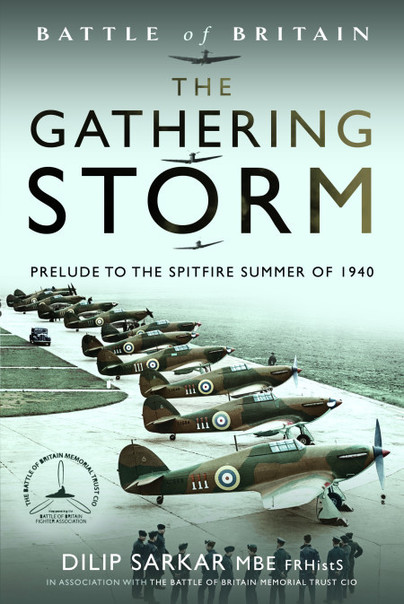Battle of Britain The Gathering Storm: Prelude to the Spitfire Summer of 1940
The Battle of Britain Memorial Trust exists to maintain The National Memorial to The Few at Capel-le-Ferne, high on the cliffs above Folkestone, overlooking the English Channel, and it seemed to me a while ago that the Trust should have its own official history of the conflict. Indeed, my Commissioning Editor at Pen & Sword, Martin Mace, and I first discussed this several years ago as a means of bringing my lifetime’s work together in a comprehensive narrative telling the ‘Big Story’ of the Battle of Britain. This, we decided, would be huge, potentially a million words in total, so needed spreading over a number of volumes – the first of which has now been published.


The plan evolved so that this first book – Gathering Storm: Prelude to the Spitfire Summer – would cover the essential background, providing context to the day-by-day events occurring between 10 July and 31 October 1940, the next six volumes each covering specific phases of the fighting, day by day, in what would be the broadest narrative written so far (and ever likely to be). The final book of the series explores how the Battle of Britain has been remembered and commemorated over the years, its place in popular and cultural history, and a guide to the various museums, memorials and certain sites of interest. The Trust was immediately enthusiastic and supportive, and following two meetings with Pen & Sword and myself the project was endorsed and agreed.


The traditional and heavily myth-laden narrative is that victory in the Battle of Britain belonged exclusively to ‘The Few’, nearly 3,000 young aircrew of Air Chief Marshal Sir Hugh Dowding’s Fighter Command, whom Churchill immortalised in his speech of 20 August 1940. But was he only talking about Fighter Command? That actually appears doubtful, because concurrently with the defensive battle Dowding’s men were fighting, aircrews of Bomber Command were both taking the war to Germany by night and by day attacking the enemy’s invasion preparations and airfields. Moreover, RAF Coastal Command also contributed through minelaying, patrolling convoys, reconnaissance and attacking German shipping, and aerial photographic reconnaissance also played its part. Moreover, the story does not just stop at aircrew: RAF groundcrews, the Royal Navy, merchant seamen, soldiers, the emergency services, anti-aircraft gunners, the Home Front – and more – are all part of this saga. So too, of course, are the Germans. And do we really understand the politics ongoing behind the scenes, and Hitler’s actual strategy towards Britain? How serious a proposition was Operation Sealion, the proposed seaborne invasion of southern Britain? How relevant are the official dates of 10 July – 31 October 1940? When did the Battle of Britain truly start? How appropriate is the criterion for inclusion amongst The Few? So many questions to explore and answer – a big story indeed.

My research has always been evidenced-based, seeking out official documents and checking first-hand testimony carefully against the known facts, and, most importantly, weaving the personal stories of those involved into the narrative – often requiring the tracing of families and access to their private archives, thus unlocking and sharing this unique material – and unpublished material, surprisingly, is still out there, as we have proved consistently. My desire to collate such material for potential inclusion in the new history led to the creation of ‘Battle of Britain: The People’s Project’, a partnership between the Battle of Britain Memorial Trust and Pen & Sword. Aimed squarely at harvesting previously unshared personal material from family archives, the Project focusses on those who lived through and experienced the ‘Finest Hour’, in whatever way – because only that collective experience enables us, nearly a century later, to better understand what happened, and why?

Now, with publication of Gathering Storm: Prelude to the Spitfire Summer our vision is becoming a reality and tangible entity. It was a challenging book to write, given the myriad of concurrent stories and threads, on both sides of the Channel, often defying a traditional chronological approach. My brief was not to produce an academic text, but something setting these aerial events into a wider context in such a way as to appeal to military aviation experts and the ‘general reader’ alike.

Volume 2, The Breaking Storm: 10 July 1940 – 12 August 1940 follows in September 2023, and Volume 3, Attack of the Eagles: 13 August 1940 – 18 August 1940 in March 2024. Currently, I am working on Volume 4, Airfields Under Attack: 19 August 1940 – 6 September 1940, which will also be released next year.
There is still time to contribute material to this long and ongoing project – so anyone wishing to get involved can contact us via The People’s Project website contact form.
Suffice it to say, for me personally this is, as another author friend put it, ‘A career-defining work’ which I feel privileged to be producing for The Battle of Britain Memorial Trust and National Memorial to The Few – and I would urge all enthusiasts to support the Trust’s vital work by becoming a ‘Friend of The Few’.

Dilip Sarkar MBE FRHistS
Order The Gathering Storm here.
Battle of Britain: The People’s Project.
Dilip Sarkar’s website.
Battle of Britain Memorial Trust Press Release.
Dilip Sarkar’s YouTube channel.



